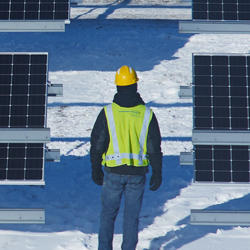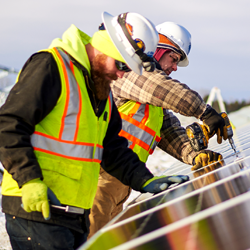Winter Solar Myths: How Solar Plants Are Built For Tough Winters
Winter is coming, and for Michiganders, this may bring many mixed emotions. Fond memories of sledding, skating and sipping cocoa are tempered by the search for shovels, scrapers and the blast of sub-zero temperatures.
Whatever the season has in store, Consumers Energy will continue to deliver the reliable, affordable and clean electricity customers need. And in the years ahead, most of that power will come from the sun — even during the dark winter months.
As solar gains momentum, it is the centerpiece of our Clean Energy Plan to meet Michigan’s energy needs over the next 20 years, protecting the environment by eliminating coal and achieving net zero carbon emissions. We plan to add 8,000 megawatts of competitively bid utility-scale solar power by 2040.
In addition to its environmental benefits, solar is increasingly cost competitive and we can add it gradually to meet Michigan’s changing energy needs without building a large, new fossil fuel power plant. We are developing solar power plants now and searching for large parcels of land for future sites. If you have a site for us to consider, please see our Solar Power and Landowners page.
But can solar power stand up to the toughest Michigan winters? Let’s look at the common misconceptions and how we expect our next generation of power plants to withstand extreme wintry conditions.
Can solar power work in the winter?
While shorter days and the sun positioned lower on the horizon decrease output, solar panels are built to keep generating clean, renewable energy throughout the winter. In fact, they’re designed to perform most efficiently as temperatures drop. The best solar production is often in later winter when the combination of cold and clear skies is perfect for producing power. How do solar panels work in winter?
How do solar panels work in winter?
Most of the solar panels generating electricity for our customers will be single-axis trackers, meaning they’ll rotate throughout the day to absorb the maximum amount of sunlight. Even in cloudy conditions throughout the year, irradiance hitting the solar panels generates electricity. We also count on battery technology to help us store electricity generated by solar and other renewable energy sources. Battery technology saves energy for those times when solar production is challenging to help meet demand for on the grid — which peaks during summer air conditioning season.
As optimistic as we are about the future of solar energy, we understand the sun doesn’t always shine — especially in Michigan. That’s one reason our Clean Energy Plan also includes the proposed purchase of an existing natural gas-fired power plant in Covert. This plant, along with our current natural gas power plants in Zeeland and Jackson, will supply reliable, on-demand electricity to meet Michigan’s energy needs when renewables such as solar and other sources are not available.
Do solar panels work in snow?
A light dusting is no big deal for solar panels. In the case of a larger storm, the single-axis tracking system can shed the snow as the panels rotate throughout the day. When the sun is out, panels also can absorb infrared heat quickly to melt snow and ice much faster than the ground or a typical rooftop.Snowfall is often a welcome sight at solar power plants. That’s because most panels are “bi-facial,” meaning they also can absorb light and generate electricity from the back side. The white snow serves as a powerful reflector, bouncing sun light back to the panels to help increase generation.
 How cold is too cold for solar panels?
How cold is too cold for solar panels?
Even the toughest Michigander winces inwardly at the thought of these biting conditions. Fortunately, today’s solar panels are built as tough as we are after earning their stripes in extreme laboratory conditions. Colder temperatures enhance production efficiency, meaning a chilly and sunny winter day is optimal for solar energy. Panels are tested at low temperatures to verify longevity and durability through various weather conditions. They also produce heat output, which keeps the solar panels from getting too cold when temperatures drop. So, it’s safe to say solar panels can tough out even some of the most intense Michigan snowstorms.“These panels are robust,” said John Gauss, a senior engineer who is part of the Consumers Energy team who specializes in solar and battery technology. “They test them by shooting ice balls at them from air cannons in the lab and for wind conditions that far exceed where we’re putting them. They can survive a typical Michigan winter, no problem.”
Interested in adding solar energy to your home? Learn more about participating in our Distributed Generation program.
Learn more about our solar plans for utility-scale solar and how we can work together by visiting our Solar Power and Landowners page.